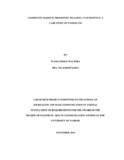| dc.description.abstract | The media in Kenya has played both constructive and destructive roles. In the 2008
post-election violence, the media was singled out as one of the actors that incited
communities leading to the loss of 1000 lives, displacement of others and loss of
property (Waki Report, 2008). In the subsequent elections of 2013, the media played a
part in pacifying communities and fostering peaceful co-existence of communities
irrespective of their political opinions and persuasions (Lockhart, K and D.2013).
This study explores the role of the community radio in promoting peaceful coexistence
of communities in a competitive political environment. The study focuses
on Pamoja FM, a community radio station located in the informal settlements of
Kibera, Nairobi. The study further examines the strategies used by community radios
to promote peaceful co-existence among ethnically diverse communities and
competitive political environments. The study also looks at the challenges faced by
community radios in their efforts of promoting peaceful co-existence.
The study was guided by Media Effects Theories specifically looking at the Agenda
Setting Theory and the Media Framing Theory. The study adopted a mixed qualitative
and quantitative research. This research focused on Lindi, Makina and Katwekera
villages of Kibera. The researcher applied cluster sampling technique to identify
samples of listeners. The researcher narrowed down to the 3 clusters. The sample size
of listeners was 135. 15 households from each of the study regions were randomly
selected. 3 respondents were selected from each of the household.
Qualitative method was used to gather narrative data. In-depth interviews were
conducted with the station’s news editor and managing director. 3 Peace building
experts and practitioners as well as 3 village elders working in each of the regions
were also interviewed. To draw inferences, the data collected was analysed and
presented in narrative form, graphs, and frequency distribution tables. Qualitative data
was presented in narrative form.
The study established that community radios play a significant role in promoting
peaceful co-existence. The study further established that they play this role by
providing a platform for community members to engage, debate and articulate their
issues. They also play this role by providing a platform for mediation during conflict
situations and covering all facets of the community in a balanced manner. The study
established that community radios are facing the challenge of optimally addressing
the diverse issues that communities are facing. This challenge is tied to lack of
adequate resources to undertake this role.
The research makes recommendations on some of the ways that community radios
bolster their efforts of promoting peaceful co-existence. These include availing
financial support to them, integrating new media technologies in their work, forging
partnerships with actors such as universities, among others | en_US |

